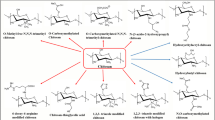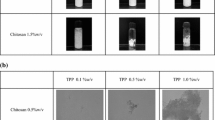Abstract
Chitosan is a promising biomaterial for biomedical applications and is currently applied as wound dressings. While chitosan solutions demonstrate strong bactericidal activity against a range of medically important bacteria, the study here reports a loss of this beneficial property in thin films cast from the same solutions. Chitosan films (20 μm) showed no inhibitory effects against Escherichia coli, Staphylococcus aureus or S. epidermidis species. In contrast, solutions used to prepare the films showed almost complete inhibition (~98 ± 2%) when tested on bacterial lawns and in liquid cultures. Increased acidity of the chitosan solutions (pH 5) was shown to promote the bactericidal effects of this biopolymer. The concept that devices fabricated from chitosan have an inherent antimicrobial activity is suggested as an important misconception.


Similar content being viewed by others
References
Beverlya RL, Janes ME, Prinyawiwatkula W, No HK (2008) Edible chitosan films on ready-to-eat roast beef for the control of Listeria monocytogenes. Food Microbiol 25:534–537
Biagini G, Bertani A, Muzzarelli R, Damadei A, DiBenedetto G, Belligolli A, Riccotti G, Zucchini C, Rizzoli C (1991a) Wound management with N-carboxybutyl chitosan. Biomaterials 12(3):281–286
Biagini G, Pugnaloni A, Damadei A, Bertani A, Belligolli A, Bicchiega V, Muzzarelli R (1991b) Morphological study of the capsular organization around tissue expanders coated with N-carboxybutyl chitosan. Biomaterials 12(3):287–291
Cho Y-W, Cho Y-N, Chung S-H, Yoo G, Ko S-W (1999) Water-soluble chitin as a wound healing accelerator. Biomaterials 20(22):2139–2145
Foster LJR, Saufi A, Holden PJ (2001) Environmental concentrations of polyhydroxyalkanoates and their potential as bioindicators of pollution. Biotechnol Lett 23:893–898
Foster LJR, Schwahn D, Pipich V, Holden PJ, Richter D (2008) SANS characterisation of polyhydroxyalkanoates and their bioPEGylated hybrids in solution. Biomacromolecules 9:314–320
Gil G, del Mónaco S, Cerrutti P, Galvagno M (2004) Selctive antimicrobial activity of chitosan on beer spoilage bacteria and brewing yeasts. Biotechnol Lett 26:569–574
Khor L, Lim LY (2003) Implantable applications of chitin and chitosan. Biomaterials 24(13):2339–2349
Lehr C-M, Bouwstra JA, Schacht EH, Junginger HE (1992) In vitro evaluation of mucoadhesive properties of chitosan and some other natural polymers. Int J Pharm 78(1):43–48
Mi F-L, Shyu S-S, Wu Y-B, Lee S-T, Shyong J-Y, Huang R-N (2001) Fabrication and characterization of a sponge-like asymmetric chitosan membrane as a wound dressing. Biomaterials 22(2):165–173
Muzzarelli RAA, Mattioloi-Belmonte M, Pugnaloni A, Biagini G (1999) Biochemistry, histology and clinical uses of chitins and chitosans in wound healing. In: Jolles P, Muzzarelli RAA (eds) Chitin and chitinases. Berkäuser Verlag, Switzerland, pp 251–264
Ouattar B, Simard RE, Piett G, Begin A, Holley RA (2000) Inhibition of surface spoilage bacteria in processed meats by application of antimicrobial films prepared with chitosan. Int J Food Microbiol 62:139–148
Raafat D, Sahl H-G (2009) Chitosan and its antimicrobial potential—a critical literature review. Microbial Biotech 2(2):186–201
Rabea EI, Badawy MET, Stevens CV, Smagghe G, Steurbaut W (2003) Chitosan as antimicrobial agent: applications and mode of action. Biomacromolecules 4:1457–1465
Rao SB, Shorma CP (1997) Use of chitosan as a biomaterial: studies on its safety and homeostatic potential. J Biomed Mater Res 34:21–28
Shigemasa Y, Shibazaki K, Minami S, Matsuhashi A, Tanioka S, Shigemasa Y (1996) Evaluation of chitin and chitosan for biomaterials. Biotechnol Genet Eng Rev 13:383–420
Wicken AJ, Knox KW (1983) Cell surface amphiphiles of gram-positive bacteria. Toxicon Suppl 3:501–512
Wilson M, Henderson B (2002) Bacterial disease mechanisms, an introduction to cellular microbiology. Cambridge University Press, UK. (ISBN-10: 052179689X)
Woolnough CA, Charlton T, Yee L, Sarris M, Foster LJR (2008) Surface changes in polyhydroxyalkanoate films during biodegradation and biofouling. Polym Int 57(9):1042–1051
Author information
Authors and Affiliations
Corresponding author
Rights and permissions
About this article
Cite this article
Foster, L.J.R., Butt, J. Chitosan films are NOT antimicrobial. Biotechnol Lett 33, 417–421 (2011). https://doi.org/10.1007/s10529-010-0435-1
Received:
Accepted:
Published:
Issue Date:
DOI: https://doi.org/10.1007/s10529-010-0435-1




